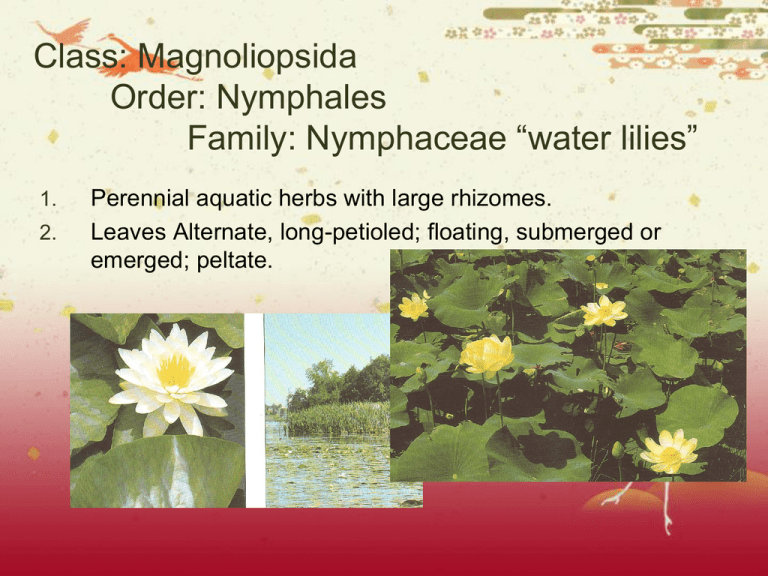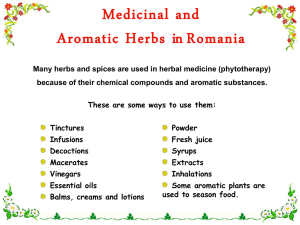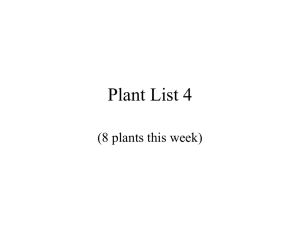PltFamsBio350
advertisement

Class: Magnoliopsida Order: Nymphales Family: Nymphaceae “water lilies” 1. 2. Perennial aquatic herbs with large rhizomes. Leaves Alternate, long-petioled; floating, submerged or emerged; peltate. Class: Magnoliopsida Order: Nymphales Family: Nymphaceae “water lilies” 1. 2. 3. 4. Perennial aquatic herbs with large rhizomes. Leaves Alternate, long-petioled; floating, submerged or emerged; peltate. Flowers bisexual; longpedunculed; floral parts numerous. CA 1-many CO 1many, A many G many. Each pistil has 1 carpel, 1 locule and parietal placentation. Class: Magnoliopsida Order: Nymphales Family: Nymphaceae “water lilies” 1. 2. 3. 4. 5. Perennial aquatic herbs with large rhizomes. Leaves Alternate, long-petioled; floating, submerged or emerged; peltate. Flowers bisexual; long-peduncled; floral parts numerous. CA 1-many CO 1-many, A many G many. Each pistil has 1 carpel, 1 locule and parietal placentation. Fruit: a spongy berry. Nymphaea “water lilies”, Nuphar “spadderdock” Nelumbo “lotus” Class: Magnoliopsida Order: Ranunculales Family: Ranunculaceae “Buttercups” 1. Mostly herbs, leaves alternate with sheathing leaf bases; mostly lobed. Class: Magnoliopsida Order: Ranunculales Family: Ranunculaceae “Buttercups” 1. 2. 3. Mostly herbs, leaves alternate with sheathing leaf bases; mostly lobed. Flowers bisexual, bisexual, actinomorphic or zygomorphic. Calyx 3 - many; Corolla 5 - many, rarely absent (calyx and corolla often not differentiated.), Androecium 3 - many, Gynecium 3- many simple pistils each with 1 carpel, 1 locule and parietal placentation. Ovary superior. Class: Magnoliopsida Order: Ranunculales Family: Ranunculaceae “Buttercups” Mostly herbs, leaves alternate with sheathing leaf bases; mostly lobed. 2. Flowers bisexual, bisexual, actinomorphic or zygomorphic. 3. Calyx 3 - many; Corolla 5 - many, rarely absent (calyx and corolla often not differentiated.), Androecium 3 - many, Gynecium 3- many simple pistils with 1 carpel, 1 locule and parietal placentation. Ovary superior. Ranunculus “buttercups”, Anemone “windflowers”, Clematis “virgin’s bowers”, Aquilegia “columbines”, Delphinium “larkspurs” 1. Class: Magnoliopsida Order: Rosales Family: Rosaceae “Roses” 1. Herbs, shrubs or trees; leaves alternate with stipules. Class: Magnoliopsida Order: Rosales Family: Rosaceae “Roses” 1. 2. Herbs, shrubs or trees; leaves alternate with stipules. Flowers bisexual, actinomorphic; sepals 5, petals 5; stamens 5 - numerous; gynecium mostly 5 or many; often perigynous (hypanthium) or inferior. Class: Magnoliopsida Order: Rosales Family: Rosaceae “Roses” 1. 2. Herbs, shrubs or trees; leaves alternate with stipules. Flowers bisexual, actinomorphic; sepals 5, petals 5; stamens 5 - numerous; gynecium mostly 5 or many; often perigynous (hypanthium) or inferior. Class: Magnoliopsida Order: Rosales Family: Rosaceae “Roses” 2. Flowers bisexual, actinomorphic; sepals 5, petals 5; stamens 5 - numerous; gynecium mostly 5 or many; often perigynous (hypanthium) or inferior. Class: Magnoliopsida Order: Rosales Family: Rosaceae “Roses” 1. 2. 3. Herbs, shrubs or trees; leaves alternate with stipules. Flowers bisexual, actinomorphic; sepals 5, petals 5; stamens 5 - numerous; gynecium mostly 5 or many; often perigynous (hypanthium) or inferior. Fruit – achene, follicle, pome, drupe. Pyrus “crabapples and pears”, Malus “apples, Rubus “blackberries and rapsberries”, Geum “avens”, Rosa “roses”, Prunus “peaches and cherries” Class: Magnoliopsida Order: Rosales Family: Crassulaceae “Stonecrop Family” 1. 2. Succulent herbs, sometimes shrubs; leaves simple without stipules; alternate or opposite. Flowers 4 to 5 merous; calyx 4-5, corolla 4-5, androecium 4-10, gynoecium 4-5 and superior; marginal placentation; scalelike gland at the base of each ovary. Ca 4-5, Co 4-5, A 4-10, G 4-5 Class: Magnoliopsida Order: Rosales Family: Crassulaceae “Stonecrop Family” 1. 2. 3. Succulent herbs, sometimes shrubs; leaves simple without stipules; alternate or opposite. Flowers 4 to 5 merous; calyx 4-5, corolla 4-5, androecium 4-10, gynoecium 4-5 and superior; marginal placentation; scalelike gland at the base of each ovary. Ca 4-5, Co 4-5, A 4-10, G 4-5 Fruit a leathery or membranous follicle (tiny seeds). Crassula “stonecrops and jade”, Sedum “hen and chicks”, Kalanchoe “bryophyllum or life plant” Class: Liliopsida Order: Juncales Family: Juncaceae “Rush Family” 1. Perennial or annual herbs; stems form tussocks or tufts; leaves sometimes reduced to a basal sheath, small. Class: Liliopsida Order: Juncales Family: Juncaceae “Rush Family” 1. 2. Perennial or annual herbs; stems form tussocks or tufts; leaves sometimes reduced to a basal sheath, small. Flowers usually bisexual, actinomorphic, small; 6 perianth segments in 2 series (Ca 3, Co 3); androecium usually 6; compund pistil of 3 united carpels; parietal placentation, ovary Class: Liliopsida Order: Juncales Family: Juncaceae “Rush Family” 1. 2. Perennial or annual herbs; stems form tussocks or tufts; leaves sometimes reduced to a basal sheath, small. Flowers usually bisexual, actinomorphic, small; 6 perianth segments in 2 series (Ca 3, Co 3); androecium usually 6; compund pistil of 3 united carpels; parietal placentation, ovary superior. Juncus “rushes” Class: Liliopsida Order: Rosales Family: Orchidaceae “Orchid Family” 1. 2. One of the largest families. Perennial herbs often epiphytic or saprophytic with rhizomes, tuberous roots or root stocks; sometimnes aerial roots. Leaves opposite, simple, often reduced to scales or fleshy; sheathing at the base. Class: Liliopsida Order: Rosales Family: Orchidaceae “Orchid Family” 1. 2. 3. One of the largest families. Perennial herbs often epiphytic or saprophytic with rhizomes, tuberous roots or root stocks; sometimnes aerial roots. Leaves opposite, simple, often reduced to scales or fleshy; sheathing at the base. Flowers bisexual and zygomorphic; calyx 3, often colored; petals 2 lateral and a middle labellum - often larger and shaped different from laterals; androecium of 1 or 2 stamens attached to column; staminoide – extension of the column; gyneocium – a compound pistil of 3 carpels; 3 stigmas; ovary inferior. Class: Liliopsida Order: Rosales Family: Orchidaceae “Orchid Family” 1. 2. 3. 4. One of the largest families. Perennial herbs often epiphytic or saprophytic with rhizomes, tuberous roots or root stocks; sometimnes aerial roots. Leaves opposite, simple, often reduced to scales or fleshy; sheathing at the base. Flowers bisexual and zygomorphic; calyx 3, often colored; petals 2 lateral and a middle labellum - often larger and shaped different from laterals; androecium of 1 or 2 stamens attached to column; staminoide – extension of the column; gyneocium – a compound pistil of 3 carpels; 3 stigmas; ovary inferior. Fruit: capsule with tiny seeds. Orchis “showy orchid”, Cyripedium “ladies slippers”, Spiranthes “ladies tresses”, Platanthera “fringed” Class: Liliopsida Order: Rosales Family: Hyperaceae “St. John’s-wort Family” 1. Leaves simple, opposite, usually entire and dotted with glands. Class: Liliopsida Order: Rosales Family: Hyperaceae “St. John’s-wort Family” 1. 2. 3. . Leaves simple, opposite, usually entire and dotted with glands. Flowers usually bisexual and actinomorphic. Speals 2 – 10; petals 2 -12 (often 5), Class: Liliopsida Order: Rosales Family: Hyperaceae “St. John’s-wort Family” 1. 2. 3. 4. 5. Leaves simple, opposite, usually entire and dotted with glands. Flowers usually bisexual and actinomorphic. Speals 2 – 10; petals 2 -12 (often 5), Stamen ususally numerous; sometimes coalescent basally in fasicles. Carpels 3 – 5; sometimes 7 (Same no. of styles. Class: Liliopsida Order: Rosales Family: Hyperaceae “St. John’s-wort Family” 1. 2. 3. 4. 5. 6. Leaves simple, opposite, usually entire and dotted with glands. Flowers usually bisexual and actinomorphic. Speals 2 – 10; petals 2 -12 (often 5), Stamen ususally numerous; sometimes coalescent basally in fasicles. Carpels 3 – 5; sometimes 7 (Same no. of styles. Parietal/axile placentation. Class: Liliopsida Order: Rosales Family: Hyperaceae “St. John’s-wort Family” 1. 2. 3. 4. 5. 6. 7. Leaves simple, opposite, usually entire and dotted with glands. Flowers usually bisexual and actinomorphic. Speals 2 – 10; petals 2 -12 (often 5), Stamen ususally numerous; sometimes coalescent basally in fasicles. Carpels 3 – 5; sometimes 7 (Same no. of styles. Parietal/axile placentation. Fruit a capule or berry. Hypericum “St. John’s-wort”, Mammea “mammea apple”, Ascyrum “St. Peter’s-wort”









